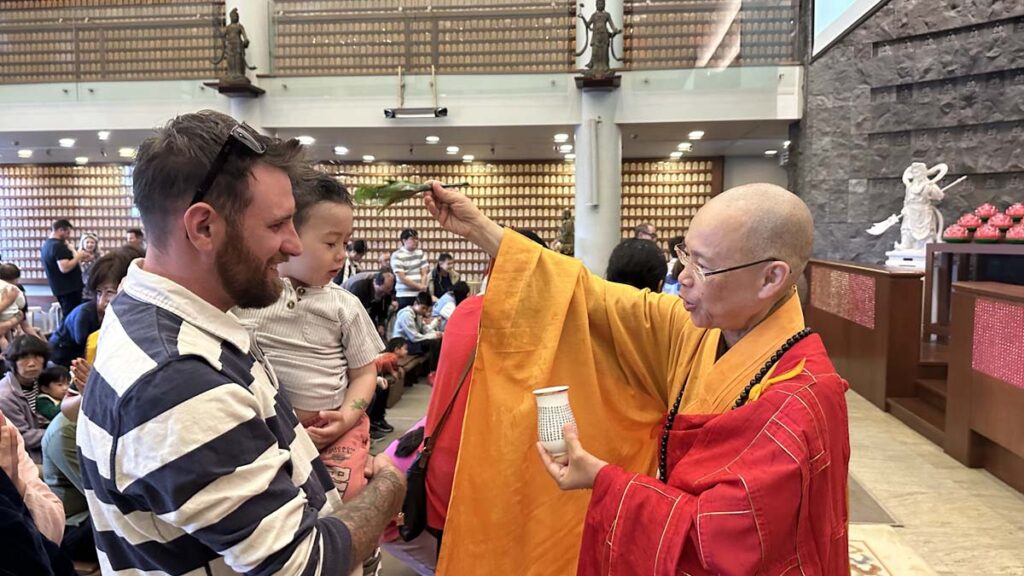The Venerable Abbess Manshin doesn’t give interviews. ‘Success isn’t about individual accomplishment but the collective power of the community. I haven’t given one in 20 years,’ the quintessential leitmotif of the Fo Guang Shan Buddhist Temple in New Zealand, told FARIDA MASTER. A rare interview with the game-changer who has transformed the cultural landscape of east Auckland.
The Abbess embodies an alchemy of fiery dynamism, quiet strength, and an aura of utmost calm as she has worked relentlessly with communities, schools, youth groups, artists, and the police alike, to make the Temple an epicentre of vibrant cultural activity.
An influential networker, the Abbess of the Fo Guang Shan Buddhist Temples both in Auckland and Christchurch has taken on some huge challenges in her stride.
She clearly defies the stereotypical description of a monastic leading a sterile life.
From the outside most people would imagine that the Abbess has an army of volunteers to organise a series of multicultural events, attended by nearly 20,000 people. Yet, when you have a peek behind-the-scenes, there is just a small group of monastic and volunteers, working day and night to make things happen with precision, élan and dignity.

Anyone who has attended the Chinese New Year Celebrations or the Buddha’s Birthday Celebration or the annual art exhibition at the Fo Guang Yuan art gallery, will know that everyone from the city’s most influential to the regulars, swarm the portals of the Temple – a study in architecture.
“Buddhism is not exclusive,” she explains about her unblinkered pursuit of connecting with communities.
“Since Gautama Buddha’s time, Buddha reached out to people as he went out to the community to collect alms. We at Fo Guang Shan hope to bring people together to develop their own potential and generate a positive attitude.”
Talking for the first time about her personal tryst with Humanistic Buddhism, she says she felt drawn to it, in her early teens.
“I wasn’t born in a Buddhist family”
“At the age of 14, I read about Buddhism being action-oriented. It’s about being a doer. I wanted to know whose teaching it was and started reading up,” she says about her calling to be a monastic.
Soon after a three-year degree in the Fo Guang Shan Tsung Lin Buddhist University which involved a lot of study, hard work, and discipline to become a monastic, she was stationed in Queensland to oversee the building of the Fo Guang Shan Buddhist Temple.
Whilst the young monastic was serving in Australia, she was summoned to Auckland by the Venerable Master Hsing Yun, Founder of the Fo Guang Shan Buddhist Order. He wanted the capable monastic who had shown sparks of dynamism to manage the building of the Fo Guang Shan Temple in Flat Bush that was facing several hurdles.
The work had come to a standstill and the Master was deeply concerned about the slow progress coupled with financial barriers that the Temple was confronted
with.
“Though I had no idea how I could make it happen, I assured the Master that I would accomplish the task if he gave me some time. I requested for permission to return to Australia before I took on the challenge of translating his vision into a reality,” she recalls.
While the Abbess pulled out all stops to raise funds for the completion of the Temple, the next challenge was to foster a deep sense of community in the suburb with a multicultural glow.
Never losing her sangfroid when the going got tough, the monastic elucidates on the power of resilience. She firmly believes that the world belongs to those who serve communities despite the speed-breakers.
“Hardship is a wonderful teacher.”
“It’s only when you come across a difficult situation, that you work towards a solution and discover the immense reservoir of strength and determination you have within. There should be no pampering. It makes people weak. Those who can take hardship have a bright future. They can take on a mission and ensure it is completed.”
The final completion of the Temple at Stancombe Road was a magnificent mission accomplished…despite the tears and turmoil involved. But she’d rather not discuss it.
Instead, we talk about the Buddhist Temple becoming a haven for local schools. Children from around 55 local schools visit the tranquil portals of the beautifully designed Temple in Auckland and Christchurch. It is here they learn about the value of 3G: Do Good Deeds, Say Good Words and Think Good Thoughts; and 4G: Giving Confidence, Joy, Hope and Convenience to others.
“Slogans we mouth must turn to action.”
“It’s important for humanity to have more strength and energy,” she says about nourishing young minds with a sense of goodness.
“A lot of times children teach their parents good values. We enable them to inculcate a positive attitude during times of trouble and help transform themselves. We also make them take a vow about cleaning their room and listening to their parents.”
Instilling a sense of goodness in young minds has been a rewarding experience. The Abbess was particularly touched when Principal Heath McNeil of Ormiston Primary School mentioned that he was grateful for the relationship they’d built with the students over the years.
McNeil felt reassured that the young students had someone to turn to during difficult times.
“Where else can they ask for help? As our children move on to intermediate school or junior college they could face more challenges and we are not always there to protect them. But they can come to the Temple for help.”
International students in the area, trying to find their feet in a new country also rely on the Temple for support. They find a sense of belonging and are appreciative of the generous lunch boxes with yummy vegetarian fare, thoughtfully packed for them by the Temple team to take home. There is enough food to share with their flatmates. It was a huge blessing for some during Covid times.
“People who walk into the Temple or pray feel a sense of peace and tranquillity. They get charged with energy,” says the Abbess.
The Police vouch for it too. Unbeknown to most, the NZ Police have held several conferences in the serene precincts of the landmark Temple. The Temple shares a close working relationship with the law-keepers of the nation.
The Abbess was chosen by former police commissioner Howard Broad to be an honorary Patron of Wing 261 to a batch of 38 constables “as she brought a unique dimension to their training,” he said of the dedicated Buddhist monastic who also organised a Crime Prevention Expo in South Auckland, and produced a handbook for new police recruits.
“We must nurture and support the guardians of law who look after us.”
“They need looking after too,” the Abbess concedes.
As if on cue, Sr Sergeant Richard Bracey walks into the Temple with a couple of constables for a quick chat. He shares saying, “After a chaotic and stressful meeting, one feels relieved and at peace just walking through the Temple grounds.”
The Temple and police have worked together on several occasions.
During Covid when local schools ran short of Rapid Antigen Test, (RAT), the Abbess took it upon herself to help by asking the Temple headquarters in Taiwan for 15,000 free RAT kits to be sent to Auckland.
“They were surprised to hear that New Zealand which was said to be the safest country in the world at the time, required them. Within hours, 97 schools registered saying they would require them.
“I was sitting at my computer for four days at a stretch answering queries from school principals till late at night.
“Under the leadership of Former Counties Manukau East Area Commander Inspector Scott Gemmell, Inspector Colin Higson and Senior Sergeant Anson Lin, the police team provided unstinted support for the distribution of supplies to schools. It was an unprecedented ‘111 delivery’ of these precious RAT kits to schools with the Temple team,” she says.
The mutually respectful relationship is a textbook example of working in unison for communities.
Another time, Former Area Commander Inspector Gemmell proposed a space of quiet reflection for his colleagues at the Ormiston Police Station.
Considering the police officers have enjoyed the peaceful atmosphere of the beautiful Temple gardens that allows them to recharge, he asked for assistance in designing a spiritually uplifting space for the front-line police officers.
Without much ado, the Abbess, and a team of 10 reached the station. They designed and constructed a five-meter-long wooden bench, plants from the Temple’s garden were replanted, stones were laid out and a stone light— symbolising a different land, but sharing the same skies was delivered to the Police Station.
“It was to bless and brighten up everyone’s hearts,” she ends.



